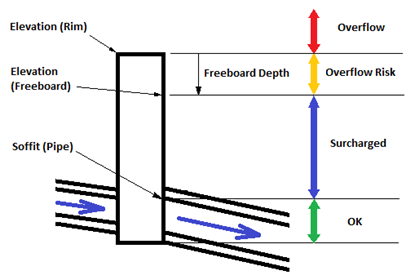Critical Storm Analysis
The Critical Storm Analysis feature analyzes the results of the selected scenarios, to determine which scenario is the most critical for each selected node. The critical scenario is the one with the highest Hydraulic Grade Line (Maximum) value. If more than one scenario has the same Hydraulic Grade Line (Maximum) value, then the scenario with the largest volume of overflow is the critical one.
Before running the critical storm analysis, the user must create and run all of the scenarios that will be evaluated in the analysis. The analysis is based on time simulations so that GVF-rational and GVF-convex (steady) cannot be used.
To access the critical storm analysis tool, go to the Compute button on the Analysis ribbon. In the drop-down menu, click Critical Storm Analysis.
When the critical storm analysis starts, it first checks to see if there are any selected nodes. If there is at least one selected node in the drawing, it will use this selection for analysis. If there are no nodes selected, then all valid nodes are analyzed. The valid types of node are:
Any inactive nodes for a scenario are ignored.
The Critical Storm Analysis determines the worst status for each node over the course of all of the scenarios. The status for a node can be one of four (4) values: OK, Surcharged, Overflow Risk, and Overflow.
- If the maximum hydraulic grade is less than the downstream pipe's soffit (inside top of pipe), the status is "OK".
- If the maximum hydraulic grade is greater than the downstream pipe's soffit, but less than the node's rim elevation minus the node's freeboard depth, the status is "Surcharged"
- If the maximum hydraulic grade is greater than the node's rim elevation minus the node's freeboard depth, but less than the rim elevation, the status is "Overflow Risk"
- If the maximum hydraulic grade is greater than the rim elevation, the status is "Overflow"
The scenario with the worst status is shown as the critical scenario for that node. If the status for a node is determined as "OK", then the first scenario with that status is shown as the critical scenario.
It is important to note that the critical storm may not be the same for every manhole or catch basin in the system. At the top of a system, a storm event with a shorter duration is likely to be critical, but working down the system, an event with a longer duration may become critical. If the system includes attenuation, such as a pond, then the critical storm event downstream of it may have a duration of days, as opposed to hours above the pond, or minutes at the top of the system.

